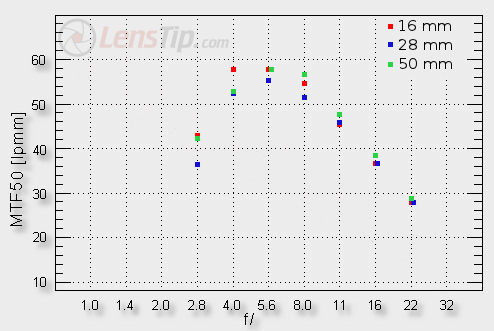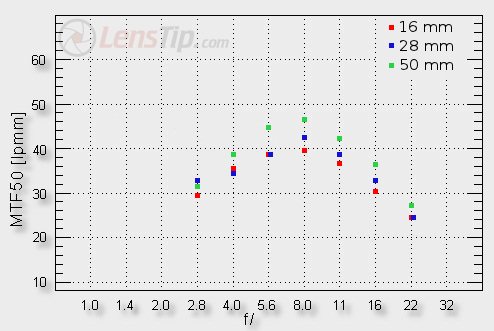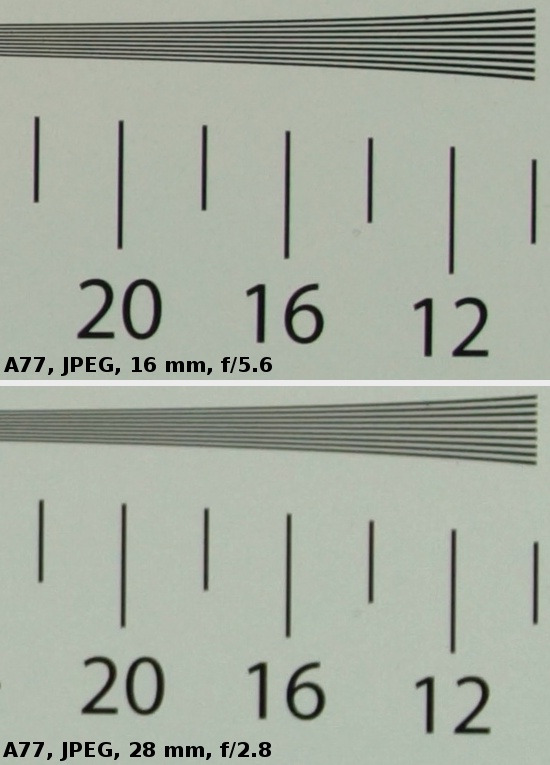Sony DT 16-50 mm f/2.8 SSM
4. Image resolution
As it is our first test based on the A77 we must write something about decency levels, set by us, and potential maximum results. Apart from the lens, tested here, we also attached to that camera such instruments as the Zeiss 24–70 mm f/2.8, the Sigma 30 mm f/1.4 EX DC and the Sony 1.4/50. The maximum MTF values which we were able to reach amounted to 61-62 lpmm. The decency level traditionally means the performance by f/16 aperture. In the case of the Sony A77 it was set on the level of about 38 lpmm. Knowing those limits you can glance at a graph below with the performance of the Sony DT 16-50 mm f/2.8 SSM in the frame centre for the beginning, middle and the end of the focal lengths’ range.

Please Support UsIf you enjoy our reviews and articles, and you want us to continue our work please, support our website by donating through PayPal. The funds are going to be used for paying our editorial team, renting servers, and equipping our testing studio; only that way we will be able to continue providing you interesting content for free. |
- - - - - - - - - - - - - - - - - - - - - - - - - - - - - - - - - - - - - - - - - - - - - - - -
The first thing which sticks out is a quite even performance. The results for all focal lengths look similar and present a very even level, What’s important, at 16 and 50 mm the MTFs exceed 40 lpmm even at the maximum relative aperture so the image you get there can be considered fully useful. Such a result is noticeably better than in the case of the Tokina and the Pentax 16-50 mm. The biggest crisis can be observed in the middle of the focal range where, at the maximum relative aperture, we see a value of less than 37 lpmm so just brushing against the decency level.
On stopping down the aperture the image quality increases very quickly and near f/5.6 reaches its maximum at all focal lengths – the MTFs get to a high level of 58 lpmm. These are hardly record-breaking values but, in the case of a zoom device which is very tricky to construct, it would be difficult to expect a better performance than that of prime lenses. The sharpness of photos remains still very good after stopping down by 1-2 EV, enough for practically all applications.
Let’s have a look at the performance on the frame edge, presented on a graph below.

Here the performance is not so even anymore – the 50 mm focal length surges upwards as it is noticeably better than the 16-28 mm range. It doesn’t change the fact that on the edge of the frame and at the maximum relative aperture the image is below the decency level. To get closer to it you have to stop the lens down by 1 EV and to have no reservations to the performance you should stop down even further - to f/5.6. This result is hardly something which can bowl you over but you should remember that neither the Tokina nor the Pentax fared here significantly better. They also had to be stopped down to about f/5.6 to guarantee a good image on the edge.
To sum up the results of the tested lens in this category can be considered as good. In the frame centre the Sony seems to have a bit better results than its 16-50 mm class competitors and on the edge all the three instruments fare very similarly.
Below we also present our test chart crops taken from JPEG files which were saved along RAW files, used for the analysis above.
 |






